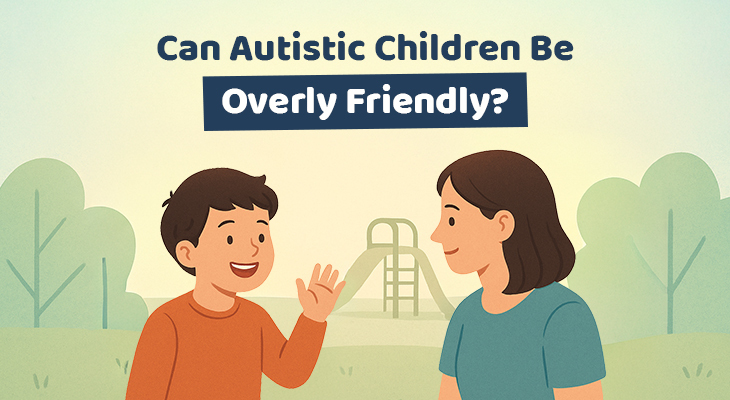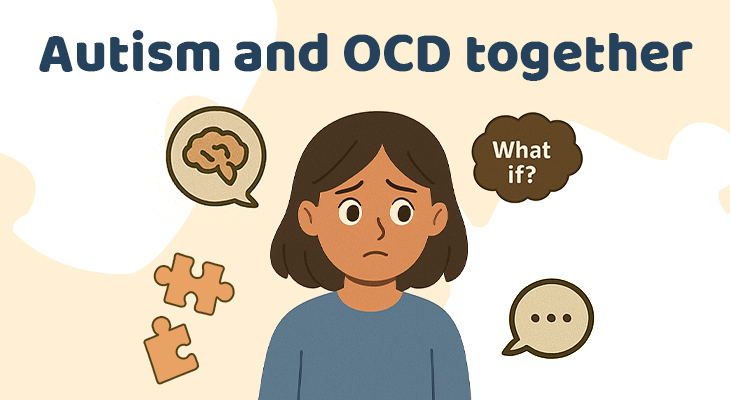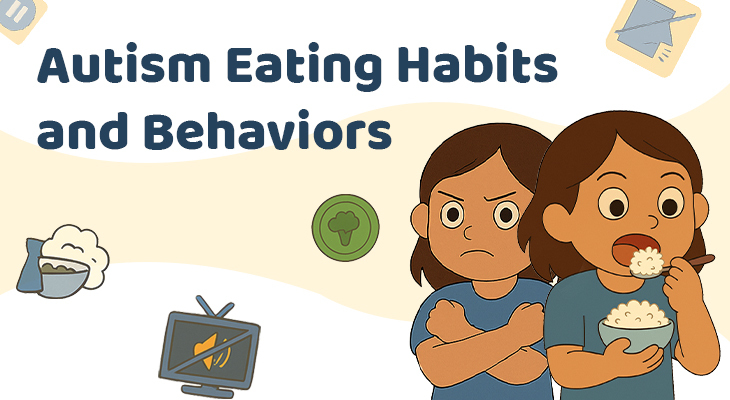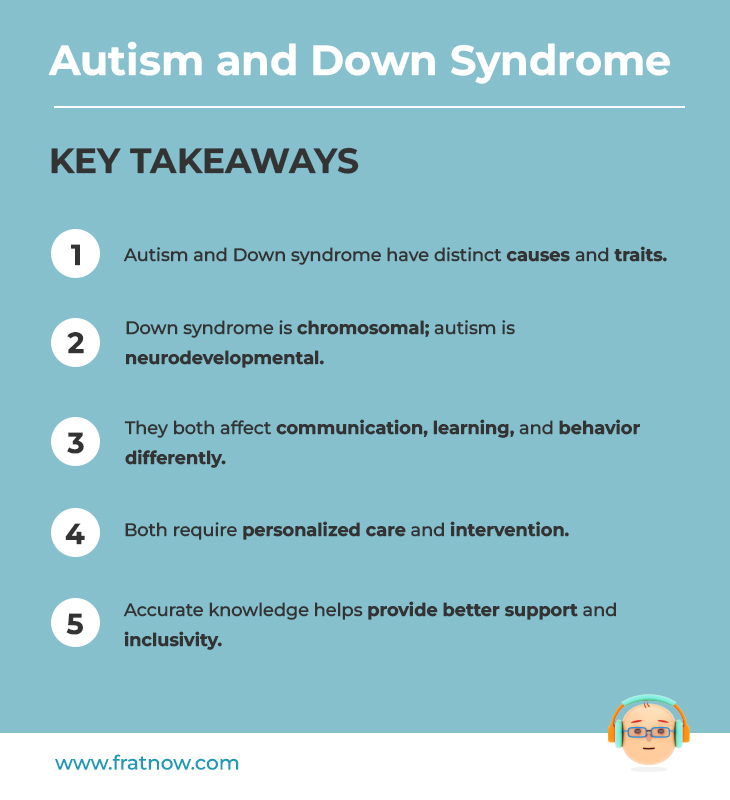
Download Download & share this Knowledge card in your network [Free Download]
Introduction
Autism and Down syndrome are distinct developmental conditions that often raise questions. While both can impact a child’s development, they have different causes, characteristics, and support needs. Hence, when it comes to autism and Down syndrome, reliable information is essential.
This blog aims to answer the most commonly searched questions and provide accurate, well-researched information to help navigate these developmental conditions.
Table of Contents
- Introduction
- Autism and Down Syndrome: Shared Traits and Key Differences
- Down Syndrome vs. ASD: Distinct Genetic Origins
- Visible Differences: Down Syndrome v/s Autism Face
- Can A Person With Down Syndrome Also Have Autism?
- What Are The Signs Of Autism In Down Syndrome?
- Down Syndrome and Autism Life Expectancy
- Did You Know?
- Conclusion
- References
Autism and Down Syndrome: Shared Traits and Key Differences
There are some similarities between Down syndrome and autism spectrum disorder (ASD), despite the fact that they are two separate disorders with different causes and fundamental traits. While acknowledging that the underlying mechanisms and display of these parallels can differ greatly, it is crucial to comprehend these similarities. Some of the similarities are as follows:
-
Developmental Delays in Autism and Down Syndrome
Shared Experience: Both autism spectrum disorder and Down syndrome involve developmental delays, meaning individuals may reach milestones such as speech, motor skills, and social skills later than their typical developing peers.
For example: In Down syndrome, developmental delays are linked to physical and cognitive challenges, such as muscle weakness. Consequently, skills like walking, talking, and self-care take longer to develop. In autism, developmental delays are more related to difficulties in communication and social interaction. While some children with autism achieve physical milestones on time, they often struggle with speech development.
Nuance: Developmental progress in Down syndrome is generally more consistent across different areas, whereas in autism, it can be uneven, some skills may develop typically or even exceptionally, while others lag significantly. For example, individuals with autism may experience developmental regression, losing previously acquired speech skills, which is rare in Down syndrome.
-
Cognitive and Learning Differences in Autism and Down Syndrome
Shared Experience: Both autism spectrum disorder and Down syndrome can impact cognitive development and learning, often requiring tailored educational approaches and specialized support. However, the way these conditions affect thinking, problem-solving, and skill acquisition differs significantly.
Nuance: In Down syndrome, intellectual disability is a defining characteristic, typically ranging from mild to moderate. This can affect problem-solving, memory, and attention, making it more challenging for them to learn new skills at the same pace as their peers. In contrast, autism presents a much wider cognitive range, from intellectual disability to giftedness. Some individuals with autism may excel in specific areas, such as mathematics or visual-spatial tasks, yet struggle with social understanding and communication.
-
Speech and Communication Challenges in Autism and Down Syndrome
Shared Experience: Both autism and Down syndrome can present challenges with speech and communication, making language development and social interaction more difficult.
Nuance: In Down syndrome, speech delays are mainly due to oral motor difficulties and intellectual disability, affecting clarity and articulation. However, they have a strong desire to communicate. In autism, communication challenges stem from difficulties in understanding social cues, nonverbal communication, and engaging in conversations.
-
Sensory Sensitivities in Autism and Down Syndrome
Shared Experience: Both individuals with autism and Down syndrome can have sensory sensitivities, though the nature and impact differ.
Nuance: In autism, sensory sensitivities are a core feature, with individuals often being overly sensitive or under-responsive to sounds, lights, textures, or smells. Everyday experiences like loud noises can be overwhelming. In Down syndrome, sensory sensitivities are less common, and when present, they tend to be milder.
-
Need for Early Intervention and Support in Autism and Down Syndrome
Shared Experience: Both autism and Down syndrome benefit significantly from early intervention and ongoing support.
Nuance: The types of interventions and support needed differ based on the specific needs of the individual. In Down syndrome, interventions often focus on physical therapy, speech therapy, and educational support. In ASD, interventions often focus on behavioral therapies, speech therapy, and social skills training.

Download Download & share this infograph card in your network [Free Download]
Down Syndrome vs. ASD: Distinct Genetic Origins
Understanding the distinct genetic foundations of Down Syndrome and Autism Spectrum Disorder (ASD) is crucial for comprehending their unique characteristics.
Down Syndrome: Down syndrome is a genetic condition known as trisomy 21, which is caused when an individual having an extra copy of chromosome 21. To make it easier to understand, let’s break it down into simple terms: most babies inherit 23 chromosomes from each parent, for a total of 46 chromosomes. Babies with Down syndrome, however, end up with three chromosomes at position 21, instead of the usual pair. This additional genetic material causes the physical and developmental characteristics associated with Down syndrome.
Autism Spectrum Disorder: In contrast, ASD is a neurodevelopmental disorder caused by a complex interplay of genetic and environmental factors, rather than by a single identified chromosomal cause.
Several factors have been linked with an increased risk of autism, such as:
- Genetics: A family history of autism and certain genetic mutations can increase the risk.
- Parental Age: Older parental age at the time of conception has been associated with an increased risk of ASD.
- Prenatal Environmental Exposures: Environmental factors like air pollution, pesticides, and maternal health issues during pregnancy may all contribute to the development of autism.
- Birth Complications: Circumstances like birth trauma that cause oxygen deprivation can increase the risk of ASD.
It is crucial to remember that, while these factors can influence the probability of developing autism, they do not directly cause the disorder. These correlations are still being investigated in order to have a deeper understanding of the complex etiology of ASD.
Visible Differences: Down Syndrome v/s Autism Face
Physically, individuals with autism and Down syndrome have different characteristics and health concerns. In autism, there are no distinct or any apparent physical facial characteristics that are universally associated with the condition.
Down syndrome, on the other hand, is distinguished by easily recognisable physical features such as almond-shaped eyes that slant upwards, a flattened facial profile, and a single deep crease across the palm.
Some of the other common identical characteristics of Down syndrome are:
- A shortened neck
- Small ears & nose
- A tongue that may stick out of the mouth
- White spots on the iris (colored part) of the eye
- Small hands and feet
- A single line across the palm (palmar crease)
- Pinky fingers that curve towards the thumb
- Poor muscle tone or loose joints
- Individuals are shorter in height
Only some people with autism may exhibit certain physical characteristics such as odd facial expressions, motor coordination difficulties, or sensory sensitivities.
Can a person with Down Syndrome also have Autism?
The short answer is yes, a person with Down syndrome can also be diagnosed with Autism Spectrum Disorder (ASD). While Down syndrome and ASD are distinct conditions, they can co-occur, presenting unique challenges for individuals and their families.
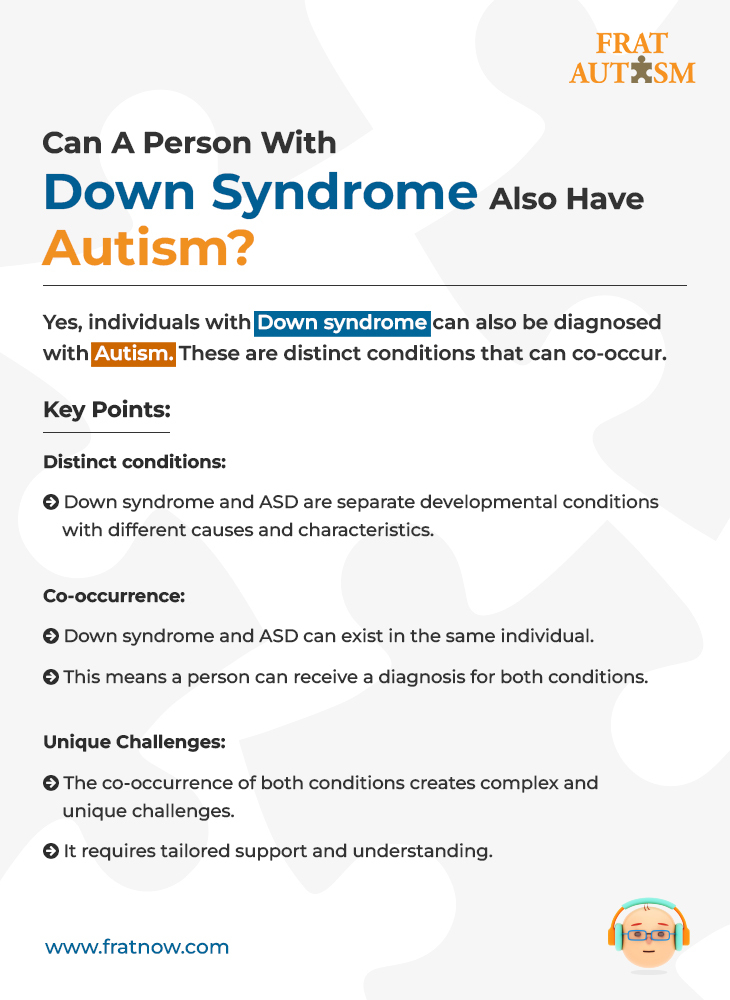
Download Download & share this infograph card in your network [Free Download]
What Are The Signs Of Autism In Down Syndrome?
The behavioral and communication challenges typically linked to Down syndrome alone can sometimes be mirrored or intensified by the symptoms of autism. These indicators may include:
- Increased difficulty with social interactions beyond what is typically observed in Down syndrome
- Repetitive behaviors and routines that are more rigid
- Challenges in adapting to changes in routine or environment, which may lead to increased distress
- Limited interest in social play, even with familiar individuals, differing from the expected level of social engagement in Down syndrome
Why might the co-occurrence of autism and Down syndrome be overlooked?
- Attribution of Symptoms: ASD-related behaviors may be seen as Down syndrome traits.
- Diagnostic Overshadowing: The Diagnosis of Down syndrome can sometimes mask other conditions like ASD.
- Variability of ASD: ASD’s wide spectrum makes identification harder in individuals with existing developmental differences.
- Diagnostic Challenges: Diagnosing ASD in individuals with Down syndrome can be challenging because some symptoms of ASD, such as communication difficulties and repetitive behaviors, can overlap with characteristics of Down syndrome itself.
Increased Autism Risk in Down Syndrome: Prevalence and Challenges
- Increased Risk: Individuals with Down syndrome have a higher risk of also being diagnosed with autism compared to the general population.
- Estimates Vary: Prevalence estimates of co-occurring autism in Down syndrome vary widely due to diagnostic challenges and differing research methodologies. Some studies suggest that around 5-15% of individuals with Down syndrome also meet the criteria for ASD. Other research indicates that the prevalence could be even higher, possibly reaching 20% or more in some populations.
- Diagnostic Challenges: Diagnosing autism in individuals with Down syndrome can be challenging because some symptoms of autism, such as communication difficulties and repetitive behaviors, can overlap with characteristics of Down syndrome itself.
Down Syndrome and Autism Life Expectancy
Many parents and caregivers are often concerned about the future, especially about the life expectancy of loved ones with Down syndrome or autism. While Down syndrome can cause health problems such as heart conditions and a higher risk of infection, medical advancements have significantly improved life expectancy. Individuals with Down syndrome now live an average of nearly 60 years, a significant increase from just 25 years in 1983.
Autism does not shorten people’s life expectancy. However, other co-occurring health conditions can occasionally have an impact. Prioritising regular health check-ups, preventive care, and early medical intervention can help people live healthier and longer lives.
Conclusion
Autism and Down syndrome are distinct conditions with unique challenges and strengths. While they share some similarities, such as developmental delays and communication difficulties, their causes, characteristics, and support needs differ significantly. Understanding these differences helps promote acceptance, early intervention, and better support for individuals and families. Instead of comparing which is “worse,” the focus should be on ensuring inclusive opportunities and improving the quality of life for all.
References
- ( https://magrid.education/autism-and-down-syndrome/)
- https://www.autismspeaks.org/down-syndrome-and-autism-spectrum-disorder-ds-asd
- https://pmc.ncbi.nlm.nih.gov/articles/PMC9979529/
- https://ndss.org/sites/default/files/archive/2017/11/2017-DS-Autism-rv3.pdf
- https://www.sciencedirect.com/science/article/abs/pii/S2212426820300336



